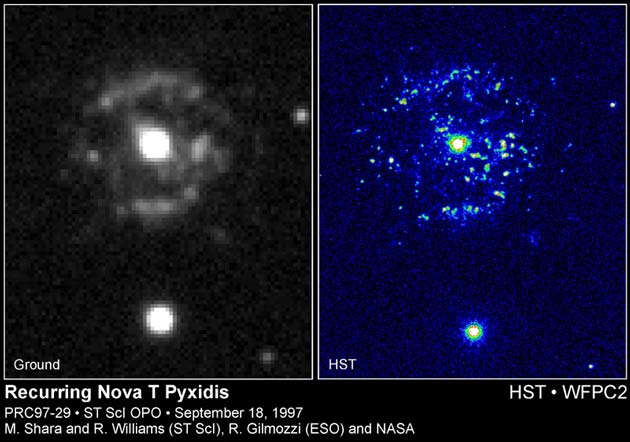
At this time of year it seems almost traditional for stargazers to ponder the age-old question of the origin of the Star of Bethlehem. The Star's appearance some 2,000 years ago is quite possibly one of the best-known celestial events in all of recorded history.
Many planetariums are currently running sky shows interwoven with a Christmas theme. Utilizing special effects projectors, audiences are transported back in time to see the night sky as the Magi may have seen it and are then asked if perhaps an unusual gathering of planets might have been the fabled star. Or was that "sign" a comet, a nova or something supernatural?
The topic has universal fascination, and is why Christmas Star shows still play to packed planetarium houses.
Perhaps the simplest answer that can be offered is that the Star might have been a nova: A "new star" suddenly blazing forth where no star had previously been seen. While for the most part such objects are really dying stars having a final fling of glory before descending the long road to ultimate extinction, there are some stars that go through such contortions more than once.
One such star is long overdue to "pop" and could do so at anytime.
The star in question is T Pyxidis, in the constellation of Pyxis, the Mariner's Compass, a dim southern constellation that never gets very high for skywatchers in the United States. For instance: as seen from Philadelphia, Indianapolis and Denver, it reaches a maximum altitude of just 18-degrees above the southern horizon (your clenched fist, held at arm's length is roughly 10-degrees in width). Currently, Pyxis is crossing the meridian around 2:30 a.m. By the end of January it will be there just after midnight and by early March, just before 10 p.m.
T Pyxidis is about 6,000 light years away and belongs to a small and seemingly "exclusive" group of cataclysmic variable stars called recurrent novae (NR)-of which there are currently less than ten confirmed members. T Pyxidis is composed of a dense white dwarf and a close companion star. An outburst occurs when the temperature and density of the surge of matter dumped from the companion onto the surface of the white dwarf reach the nuclear flash point for hydrogen. While material is violently blown off in all directions (see comparison photos from both ground-based instruments and the Hubble Space Telescope here), the white dwarf itself is not disrupted and soon begins to accumulate more matter from its companion, and repeats the cataclysm some years later.
Get the Space.com Newsletter
Breaking space news, the latest updates on rocket launches, skywatching events and more!
Astronomers have been patiently waiting for T Pyxidis's next outburst for more than 20 years.
Normally this star shines at magnitude 14-that's about a thousand times dimmer than the faintest star that can be perceived by most human eyes on a dark, clear night. But on five occasions, in 1890, 1902, 1920, 1944 and 1967, this star brightened dramatically to magnitudes between 6.5 and 7 - a 1,000-fold increase in brightness in the most extreme case-making T Pyxidis just bright enough to be glimpsed without any optical aid. These eruptions came at an average of just over 19 years apart, and the longest stretch of time between them was 24 years.
But this month marks 40 years since the last outburst.
It was back on Dec. 7, 1966 that the most recent eruption was first noticed by New Zealand amateur astronomer, Albert Jones. The star had more than doubled in brightness to magnitude 12.9. Just two nights later it was almost four magnitudes brighter and after a month it was glowing at magnitude 6.3 before slowly fading back to normal.
Nobody knows exactly why T Pyxidis has remained quiet for so long, but the general consensus is that it may have accumulated an extra-thick coating of nuclear fuel on its surface over these past 20 years, which would make it appear extra bright when it finally blows its next surge of gaseous debris out into space.
Who knows? That night could be tonight!
- Star of Bethlehem: Going Back in Time to Examine Its Origins
- Venus: The Evening Star Has Returned
- 10 Steps to Rewarding Stargazing
- Sky Calendar & Moon Phases
- Astrophotography 101
Joe Rao serves as an instructor and guest lecturer at New York's Hayden Planetarium. He writes about astronomy for The New York Times and other publications, and he is also an on-camera meteorologist for News 12 Westchester, New York.
Join our Space Forums to keep talking space on the latest missions, night sky and more! And if you have a news tip, correction or comment, let us know at: community@space.com.

Joe Rao is Space.com's skywatching columnist, as well as a veteran meteorologist and eclipse chaser who also serves as an instructor and guest lecturer at New York's Hayden Planetarium. He writes about astronomy for Natural History magazine, the Farmers' Almanac and other publications. Joe is an 8-time Emmy-nominated meteorologist who served the Putnam Valley region of New York for over 21 years. You can find him on Twitter and YouTube tracking lunar and solar eclipses, meteor showers and more. To find out Joe's latest project, visit him on Twitter.